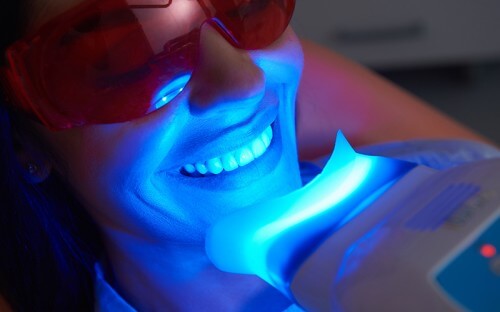This Valentine’s Day, forget the candy hearts and roses and give yourself the gift of a brighter, whiter smile.
As children, our teeth are naturally bright and white. But as we age, our smiles can get dingy and stained. There are many reasons, including tooth trauma, food and drink choices, tobacco use, childhood illnesses, and even chemotherapy. Stained teeth can make a person look aged beyond their years and can affect a person's self-esteem by making them not want to smile.
Some of these stains can be removed with twice-daily brushing and flossing and regular professional cleanings. For that deep-down staining, there are many options available to every patient.
Recent surveys suggest that almost 15 percent of the American population whitens their teeth. That's over 45 million people in the United States alone.
Before we get into options for whitening, it's important to remember that some teeth will not lighten regardless of the method used. Whitening won't work on teeth with crowns, veneers, fillings, or dentures. Teeth where the nerve has suffered trauma, or have already been stained due to medication while the tooth was forming also can't be lightened by surface bleaching.

Whitening Options
So how does teeth whitening work? There are essentially only two tooth whitening agents used: hydrogen peroxide and carbamide peroxide. It's the delivery method that offers the widest choice for patients.
In-Office Whitening - Sometimes called chairside whitening, this process is usually done in one visit. The concentration of this gel is powerful. Your dentist will protect your gums so that none of the bleaching agent touches your delicate oral tissue. Since a bright light often activates this material, protective eyewear must also be worn.
At-Home Trays - After your dentist takes impressions of your teeth, they will make a custom set of trays to fit for you. You'll be given a syringe of whitener, which can vary in strength from 10-35% depending on the material used, as well as detailed instructions.
Whitening Toothpaste - For light surface stains, over-the-counter whitening toothpaste will work just fine. These pastes usually have added polishing agents like baking soda that act as abrasives, scrubbing away the stains of everyday life.
Teeth Whitening Strips - These strips are available in stores and through your dental office. They work best on people who have straight teeth, as the whitening strip needs direct contact to work. The bleaching agent in these strips is weaker than your dentist would use during an in-office treatment.
Side Effects

Generally speaking, teeth whitening is very safe. However, some people may develop tooth sensitivity if they use a highly concentrated whitening agent. Gum recession, which exposes the sensitive dentin under the enamel, can also cause tooth sensitivity during whitening.
Using a toothpaste for sensitive teeth and limiting the time you whiten can lessen these symptoms. If you experience any tooth sensitivity, be sure to call your dentist and make sure there isn't another cause for your discomfort.
If you try an over-the-counter whitener, look for an American Dental Association seal of approval to make sure the product has been tested and deemed safe for at-home use.
Between Touchups
Regardless of the whitening method used, your teeth will need to be touched up occasionally to maintain their radiance. Twice daily brushing and flossing combined with regular professional cleanings and exams are one of the most effective ways to not only keep your body healthy but your smile bright. Limiting foods like coffee, wine, and tea can help increase the time between touchups, too.
This Valentine's Day, why not give yourself the gift of a beautiful smile you can't wait to love.